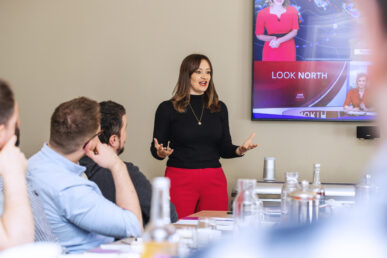“If we all did the things we are capable of doing, we would literally astound ourselves.“
5 Tips To Deliver A Great Presentation
We’ve all been there. You’re in the hot seat, your heart is beating fast, and you have to deliver the presentation of a lifetime. Whether you’re pitching a new product to potential investors or presenting your quarterly results to the board, nailing that big presentation is essential to your success. So how do you do it? Here are 5 expert tips:
Start with a bang
The first few minutes of your presentation are crucial in setting the tone and grabbing your audience’s attention. Knowing your audience is key to this because your message has to be what THEY want to hear – not what you want to say. Using storytelling is a great way to structure your presentation and is a time-honoured way to engage an audience and keep them interested in what you have to say. How many times have you seen a presentation start with the dreaded agenda slide? Instead, borrow story elements such as characters, challenges, and goals to hook your audience from the start. Staying with characters for a moment – set yourself up as the mentor and the audience as your hero. They will often be facing challenges or have something missing or broken in their world, which you have the expertise or insight to help with. Your goal is to help them overcome these challenges and provide them with a new way of looking at things.
This type of storytelling structure immediately engages your audience, making them more receptive to what you have to say. Remember, people love stories!
Be credible
If you want to engage an audience they will need to trust you, and for them to trust you, you’ll need to be credible. People often think credibility is having the right credentials and being an expert in your field, and of course, this is important. It’s what we call logical credibility. But being credible also means being vulnerable and sharing your own challenges and experiences that relate to your audience – emotional credibility. Saying, ‘I’m like you, and I understand your world’. Being open and honest will make you more relatable to your audience. This ties in with the Greek philosopher Aristotle and his three pillars of rhetoric, which for thousands of years have provided a framework for building trust and persuading your audience.
The three pillars are ethos, pathos, and logos. Ethos is about establishing your credibility as a speaker. Pathos is about connecting with your audience emotionally. Logos is about using logic and reasoning to make your case. By using all three pillars, you can create a well-rounded argument that is more likely to persuade your audience.
Keep it simple
When you’re nervous, it’s easy to try and pack too much information into your presentation. But this will only overwhelm your audience and muddle your message. Instead, follow the psychological principle of the rule of three, which states that information that comes in threes is more memorable and persuasive than other numbers of things. This is because our brains are wired to process information more efficiently when it is chunked into manageable groups of three. For example, when we see a list of items, we are more likely to remember the first three and the last three items on the list than the items in the middle. Similarly, when we hear a presentation that is structured around three main points, we are more likely to recall those points than if the presentation consisted of five or seven points.
This principle exists in many stories too. The Three Little Pigs, The Three Musketeers, Aladdin and his three wishes. Big brands will also use this trick to help you remember their product – from Nike’s ‘Just Do It’ and Rice Krispies ‘Snap, Crackle, Pop’ to political slogans ‘Yes We Can’ and ‘Get Brexit Done’.
The rule of three also makes presentations more enjoyable to listen to. Because our brains crave structure and clarity, a well-organised presentation that follows the rule of three will be more satisfying to listen to than a meandering one that tries to cover too many topics. Additionally, the rule of three can help to keep your audience engaged by providing them with a sense of what is coming next and helping them to follow your train of thought.
Be congruent
Your words, tonality, and body language all need to be saying the same thing for you to be congruent. If not, your audience will sense that something is off and won’t trust you. Be aware of your posture. Are you swaying or making unnecessary movements making you appear nervous? Is your voice pitched too high or low? Are you making eye contact? If the answer to that last question is yes, are you making eye contact with everyone in the room, not just the decision-maker? Consider the gestures you’re using too. A ‘palms down’ gesture is great for a definitive statement or explaining that something is important. Use a ‘palms up’ gesture to show openness, moments of inspiration or to welcome everyone to the presentation.
It can be helpful to record yourself on video so that you can see and hear how you come across to others. Alternatively, ask a friend or family member to listen to your presentation and give you feedback.
Keep your monkey mind under control
The monkey mind is that little voice inside your head that’s constantly chattering away, making you second-guess yourself and doubt your ability to deliver a great presentation. It’s your emotional brain taking over and blocking out the logic. The key to keeping it under control is to use a mantra – a short, positive phrase that you repeat to yourself throughout the presentation. Now, your monkey mind is very clever and if you say, ‘I’m calm, and I’m in control’ when your heart is racing, your monkey will say, ‘No, you’re not!’ so make sure your mantra is something which is true, and your monkey can’t argue with. It could be ‘I’m in the right place’ or ‘I’ve done this before, and I can do it again’. The mantra will help to keep you grounded and focused on what you’re doing in the here and now rather than letting your monkey mind take over.
Visualisation
Another way to keep your monkey mind under control is to visualise yourself giving a great presentation. Picture yourself speaking confidently, making eye contact with your audience and delivering the presentation flawlessly. This is something which top athletes do and is often called ‘future history’ where you focus with such extreme intent on a positive outcome that it feels like it’s already happened. Muhammed Ali is one famous example where he focused with such intent on the outcome of his matches that he could predict in which round and with which punch he would win.
Clients will sometimes say to us that they can’t visualise. Except they can, they tend to visualise a negative outcome! If you can do that you’re already visualising the future but from a negative perspective, flip it around and focus on a positive outcome. Olympic gold medallist and World Champion Heptathlete Jessica Ennis-Hill says she visualises winning her races over 1000 times before the event and GB cyclist Sir Chris Hoy often speaks about how visualisation helped him overcome his doubts to win multiple gold medals.
Giving a great presentation is not just about the content – it’s about how you deliver it. By following these five tips, you can be sure that you’re making the most of your natural ability and giving yourself the best chance to engage with your audience, build rapport and deliver a presentation that will get results.
I’ll leave you with the words of Thomas Edison. “If we all did the things we are capable of doing, we would literally astound ourselves.”
Can We Help You Deliver A Great Presentation?
Still need some help? We offer many options to help you or your team present like a pro. From our popular dynamic presenter course or 121 presentation coaching, we have something to fit all time frames and budgets. Get in touch today to discuss how we can help you achieve your communication goals.
You can also watch or listen to our podcast below, where Richard and Alina share tips on how to improve your body language and communication skills to help you deliver great presentations.
The Body Talk Podcast – Improve Your Body Language And Communication Skills from Body Talk on Vimeo.





















